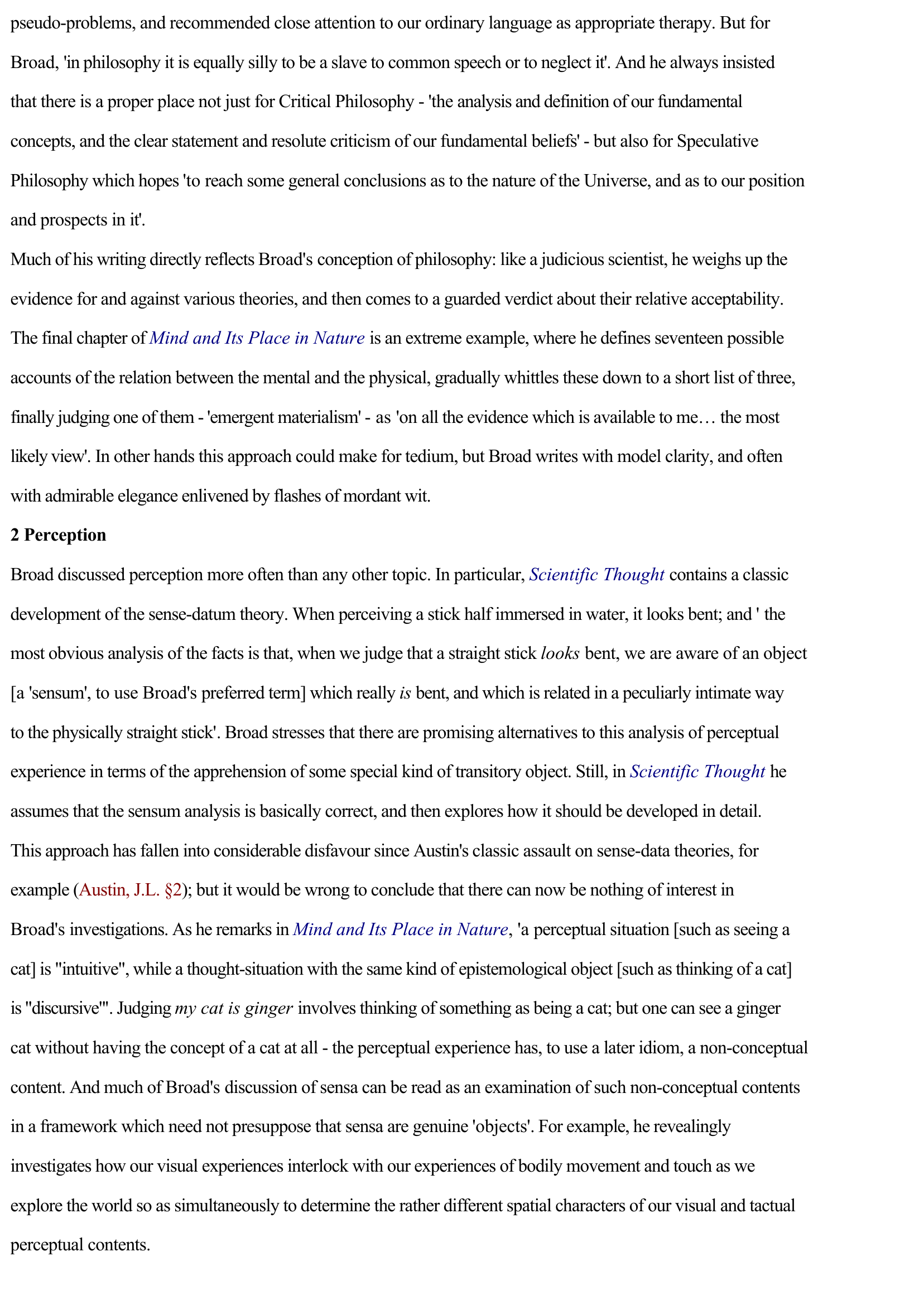Broad, Charlie Dunbar
Publié le 22/02/2012
Extrait du document
«
pseudo-problems, and recommended close attention to our ordinary language as appropriate therapy.
But for
Broad, 'in philosophy it is equally silly to be a slave to common speech or to neglect it'.
And he always insisted
that there is a proper place not just for Critical Philosophy - 'the analysis and definition of our fundamental
concepts, and the clear statement and resolute criticism of our fundamental beliefs' - but also for Speculative
Philosophy which hopes 'to reach some general conclusions as to the nature of the Universe, and as to our position
and prospects in it'.
Much of his writing directly reflects Broad's conception of philosophy: like a judicious scientist, he weighs up the
evidence for and against various theories, and then comes to a guarded verdict about their relative acceptability.
The final chapter of Mind and Its Place in Nature is an extreme example, where he defines seventeen possible
accounts of the relation between the mental and the physical, gradually whittles these down to a short list of three,
finally judging one of them - 'emergent materialism' - as 'on all the evidence which is available to me… the most
likely view' .
In other hands this approach could make for tedium, but Broad writes with model clarity, and often
with admirable elegance enlivened by flashes of mordant wit.
2 Perception
Broad discussed perception more often than any other topic.
In particular, Scientific Thought contains a classic
development of the sense-datum theory.
When perceiving a stick half immersed in water, it looks bent; and ' the
most obvious analysis of the facts is that, when we judge that a straight stick looks bent, we are aware of an object
[a 'sensum' , to use Broad's preferred term] which really is bent, and which is related in a peculiarly intimate way
to the physically straight stick '.
Broad stresses that there are promising alternatives to this analysis of perceptual
experience in terms of the apprehension of some special kind of transitory object.
Still, in Scientific Thought he
assumes that the sensum analysis is basically correct, and then explores how it should be developed in detail.
This approach has fallen into considerable disfavour since Austin's classic assault on sense-data theories, for
example ( Austin, J.L.
§2 ); but it would be wrong to conclude that there can now be nothing of interest in
Broad's investigations.
As he remarks in Mind and Its Place in Nature , 'a perceptual situation [such as seeing a
cat] is "intuitive", while a thought-situation with the same kind of epistemological object [such as thinking of a cat]
is "discursive" '.
Judging my cat is ginger involves thinking of something as being a cat; but one can see a ginger
cat without having the concept of a cat at all - the perceptual experience has, to use a later idiom, a non-conceptual
content.
And much of Broad's discussion of sensa can be read as an examination of such non-conceptual contents
in a framework which need not presuppose that sensa are genuine 'objects' .
For example, he revealingly
investigates how our visual experiences interlock with our experiences of bodily movement and touch as we
explore the world so as simultaneously to determine the rather different spatial characters of our visual and tactual
perceptual contents..
»
↓↓↓ APERÇU DU DOCUMENT ↓↓↓
Liens utiles
- Le personnage de MOREL Charles, dit Charlie de Marcel Proust
- Charlie Parker
- Parker (Charles Christopher, dit Charlie)
- Parker (Charles Christopher, dit Charlie)
- Chaplin (Charles Spencer, dit Charlie)

































